Big cat country
Monohulls still comprise the lion’s share of the fleet, but could large multihulls ever overcome current prejudices to become the new kings of the jungle?
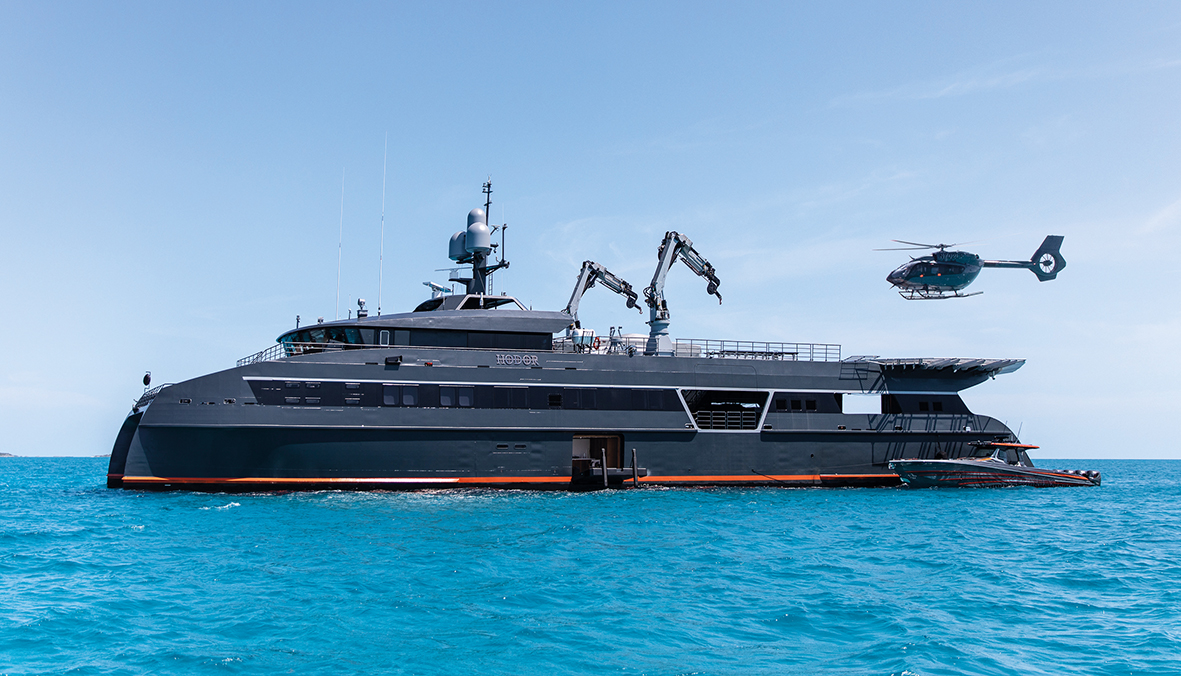 SHADOWCAT’s 66-metre M/Y Hodor
SHADOWCAT’s 66-metre M/Y Hodor
Despite their allure with increased gross tonnage, greater fuel efficiency and enhanced stability, interest in large multi-hulls has been relatively slow, with most movement seen below 30 metres. Yes, there have been some famous launches in recent years and some seriously eye-catching support vessels joining the fleet, but multihull vessels are still rare gems, rarely seen in the superyacht sector.
So what factors have contributed to this cautious approach, what’s the potential of multihulls in the future of yachting, and what lessons can be learned from past launches in both the yachting and support-vessel sectors?
“There’s a slow uptake on the upper scale, which is ironic because you’d think the top shipbuilders would be more adventurous and cutting-edge,” says Jennifer Smith, director of business development at SHADOWCAT, a builder of large luxury multihull support vessels. “I think there are a few factors at play, with one of the bigger ones being operational resistance.
“While owners are excited enough to call us directly, once they involve their operational crew, enthusiasm tends to fade. This might be due to the inexperience of marine departments in handling large cats, which require different navigational approaches more common in the commercial sector.”
Multihulls aren’t a modern concept in the maritime industry by any means, and decades of research in commercial and naval marine sectors has been spent evaluating multihull platforms for various vessel types, sizes and speeds. James Roy, managing director of Lateral Naval Architects, explains that, as seasoned commercial catamaran designers, the firm first delivered a 38-metre catamaran superyacht in the early ’90s. “We thought that the then relatively infant superyacht industry would be in awe of this and many more would follow.”
However, the phone didn’t exactly ring off the hook, and big cats have never really gained any significant market share since. Roy adds that a few years after their 38-metre yacht’s delivery, the owner invited them on board. “While on the aft deck, he expressed his fondness for the yacht, but felt uneasy when berthed stern to alongside sleek monohulls with raked bows. The owner then pointed and said, ‘I want my yacht to look like that’. He was, of course, pointing to a monohull.”
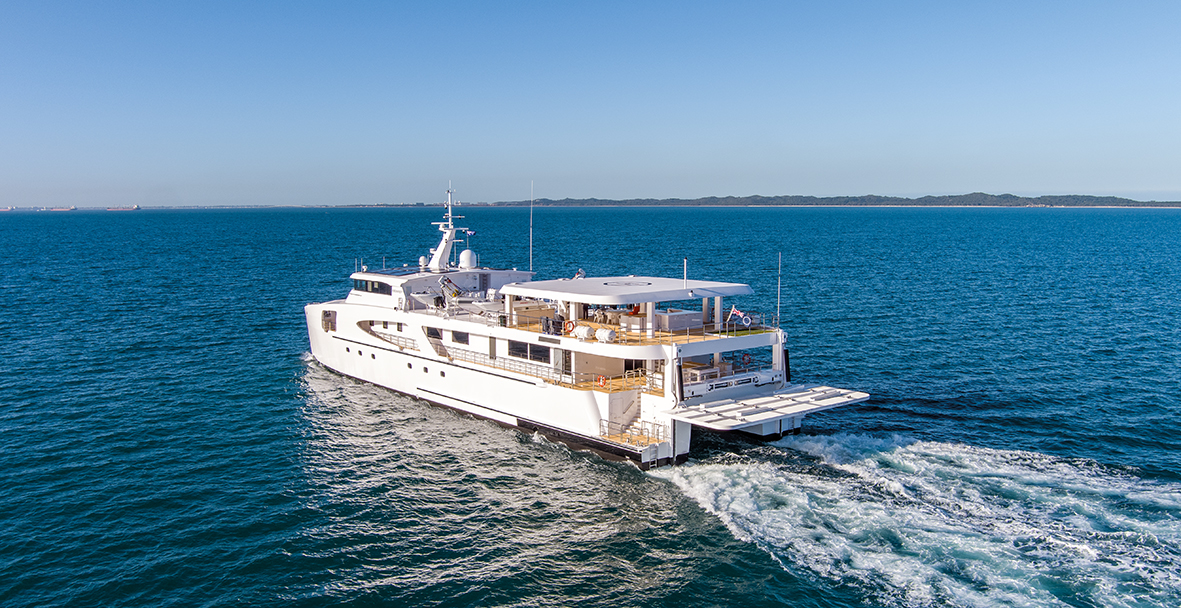 M/Y Charley 2, 56-metre aluminium catamaran
M/Y Charley 2, 56-metre aluminium catamaran
We were surprised by this; from conversations at boat shows and in interviews, catamarans had appeared to be rising in popularity – but the data says otherwise. According to Superyacht Intelligence, only 12 multihulls over 30 metres have been delivered since 2019, four of which are support vessels. The most recent deliveries of both yachts and support vessels have been Viaraggio-based Tecnomar’s 43-metre motoryacht This Is It and Australian shipyard Echo Yachts’ 56-metre Charley 2. Both are the largest catamarans built by their respective shipyards, with the latter being the biggest catamaran motoryacht ever built in Australia, representing a shift in construction methods towards multihulls, small though it may be.
Whether the slow uptake is down to a lack of operational or construction knowledge, infrastructure, education on their benefits or simply aesthetic hang-ups is unclear. What is clear, however, is that there’s a lot the superyacht industry can learn from the commercial and support-yacht sectors. Their adoption of multihull construction methods to increase useable space and stability on board, and boost fuel efficiency while reducing operational costs, are innovations to aspire to should the fleet wish to continue its evolution.
This is the key point to consider when discussing multihulls – their design enhances hydrodynamic efficiency in the water due to their slender hulls, meaning they require less engine power and fuel to achieve the same speed or range compared to traditional single-hull vessels. The same principles apply to trimarans, which consist of a long, slender central hull and two smaller outer hulls. This configuration acts as a stabilised monohull, with the outer hulls providing additional stability as well as enhanced hydrodynamic efficiency.
By dividing the displacement between two or more hulls, the length-to-displacement ratio is improved and, in turn, the wave-making component of the drag is substantially reduced. “Across much of the speed range of interest, the wave-making drag is the dominant component, and it is the length-to-displacement ratio which is the most influential variable,” explains Roy. “It is often cited that the benefit of the multihull is derived from the very slender hulls, as characterised by the visibly low waterline beam of each hull. However, this is a second order variable and it is length in relation to displacement which is the most influential.”
The disadvantage to dividing up the displacement, however, says Roy, is that it increases wetted surface area, leading to higher frictional drag. In segments of speed-to-length ratio where wave-making drag dominates (moderate to higher speeds), the multihull will therefore be at an advantage, while in areas where frictional drag is dominant (low and very high speed) multihulls have a higher drag than a monohull. Multihulls also dsiplay wave interference effects from the component hulls, varying in effects on drag. But these effects tend to only be pronounced at lower speeds and heavier displacements.
A trimaran rolls around a single longitudinal centre point like a monohull, providing stability and efficiency similar to a catamaran with the aesthetic appeal and motion similar to a traditional monohull, combining the best of both worlds.
They are also typically constructed from lighter materials such as aluminium, which reduces submerged hull area, minimising wetted surface area, and further reducing hydrodynamic drag and fuel consumption. For instance, compare a 92-metre monohull to Echo Yachts’ 84-metre White Rabbit. Despite having a similar gross tonnage, the monohull requires 7.2mW of power to achieve a top speed of 19 knots. In contrast, White Rabbit needs only 4.2mW to reach 18.7 knots – towards a 40 per cent reduction of installed engine powering requirement, accord-ing to Echo Yachts’ sales and marketing manager Chris Blackwell. When considering that the industry has spoken extensively about its aspirations to decarbonise and adopt more environmentally friendly practices, multihulls present a compelling option.
“If everyone in the industry genuinely wants to make a really big dent in CO2 emissions and make yachts more environmentally friendly, while simultaneously lowering your fuel costs, catamarans and, moreover, trimarans are the way to go,” says Blackwell.
“We’ve made these boats more efficient from existing technologies. If the industry were to then integrate emerging solutions like hydrogen fuel cells and diesel-electric propulsion systems into our platform, it could enhance efficiency even further, beyond the 40 per cent benchmark.”
The stability of catamarans is often cited as a core factor in their appeal. With a monohull, whether you’re powering along or at anchor, there’s a distinct roll characteristic from port to starboard. It’s a longitudinal motion that rolls back and forth. “However, with a catamaran, the motion is different. It’s a slightly more noticeable motion, shifting weight from one hull to the other,” says Blackwell. “While this is less noticeable when the catamaran is moving, it can be slightly more pronounced when anchored.”
Here is where trimarans offer a distinct advantage. As a stabilised monohull, a trimaran rolls around a single longitudinal centre point like a monohull, providing stability and efficiency similar to a catamaran with the aesthetic appeal and motion similar to a traditional monohull, combining the best of both worlds.
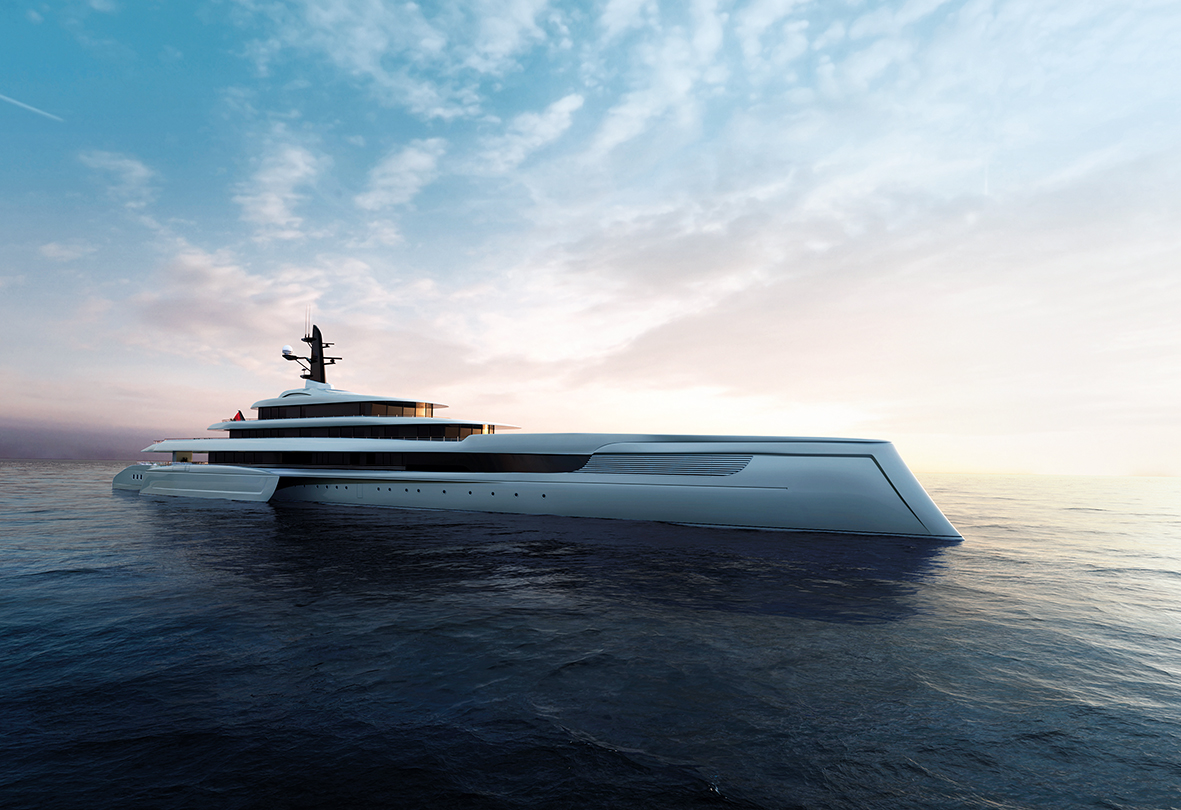 Spear, Lateral Naval Architects’ 140-metre trimaran project, which offers a 40 per cent increase external space while keeping the internal area similar to a 110-metre monohull.
Spear, Lateral Naval Architects’ 140-metre trimaran project, which offers a 40 per cent increase external space while keeping the internal area similar to a 110-metre monohull.
Image credit: T. Fotiadis Design
Looking to execute its multihull expertise, Lateral Naval Architects has unveiled Spear, an ambitious 140-metre trimaran project that aims to combine comfort, expansive open spaces and enhanced hydrodynamic efficiency and stability. By design, the relatively small sponsons contribute to a platform that needs little support from active stabilisation. The stabilised monohull concept introduces more advantages by also offering a spacious platform, with a 40 per cent increase in highly sought-after external space while keeping the internal area similar to a 110-metre monohull.
This lesson in stability is one best learned from the support-yacht sector. With the industry evolving, Robert Smith, CEO of SHADOWCAT, says there has been a notable shift towards clients buying smaller vessels and purchasing a shadow yacht to carry its tenders, with owners less willing to invest in a 100-metre yacht with its hefty operational expenses.
He adds, “This trend mirrors what we’ve observed in the support-vessel sector, where we’ve been involved for over 15 years. Building a 70-metre vessel allows access to the best ports and offers flexibility in terms of operations. If you look at what we did with Hodor, that was all about launching and recovering large tenders and heavy weights.
“It is so stable and has a much higher metacentric height [GM] than a mono hull, so it can handle the transfer of these weights with no problem. Subs are becoming more popular, and these things can weigh up and over 10 tonnes, so that is why a catamaran platform is perfect.”
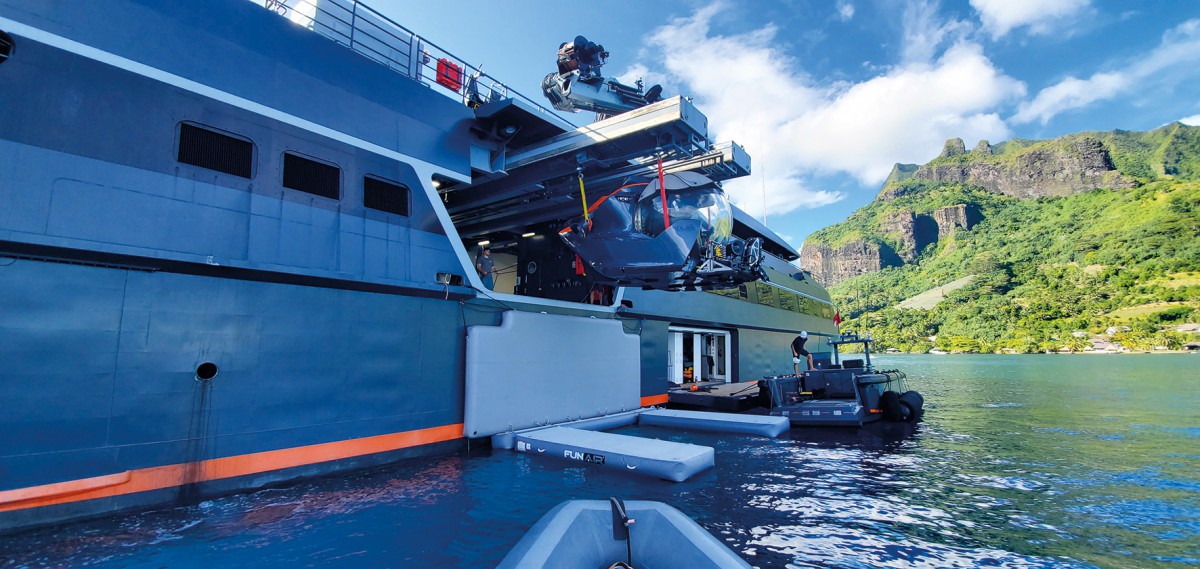 Deploying the sub on Hodor
Deploying the sub on Hodor
Choosing a catamaran for your support vessel is cost-effective too, with the idea of designing two smaller vessels together becoming more common to reduce both the footprint and operational expenses. According to Smith, several prospective buyers have opted for a different approach, however, and are looking to use a large multihull as their primary vessel.
It’s easy to see why, as when considering its efficiency and ocean-going capabilities, it also offers a wealth of useable space, typically a lot more than that of a monohull with the same LOA. In terms of space, the outdoor entertaining areas, abundant storage space for tenders and the enhanced potential for certified helicopter pads make catamarans and trimarans well-suited to the features preferred in a superyacht, not just a support vessel.
Their construction from aluminium also allows for a shallow draught, letting them to access more exotic and exclusive shallow locations that are typically inaccessible to heavier, deep steel-constructed monohulls. As for challenges in building multihulls compared to monohulls, catamarans often have two engine rooms, one on each side. While this set-up duplicates systems such as electrical, control and fuel, it also offers redundancy. In the event of damage to one engine room, the vessel can still operate with the other.
One of the primary challenges for multihull ship builders is to ensure the yacht’s structural integrity and stability.
“Aluminium fabrication also tends to be a little more challenging and requires a higher level of skill compared to steel. Aluminium welders can more easily transition to welding steel, but it’s more challenging for steel welders to adapt to welding aluminium,” explains Blackwell. “Unlike steel, aluminium can require more care in weld sequencing and other techniques to control plate distortion and ensure a high quality result. However, this is only a challenge for companies that lack experience and proficiency with aluminium construction.”
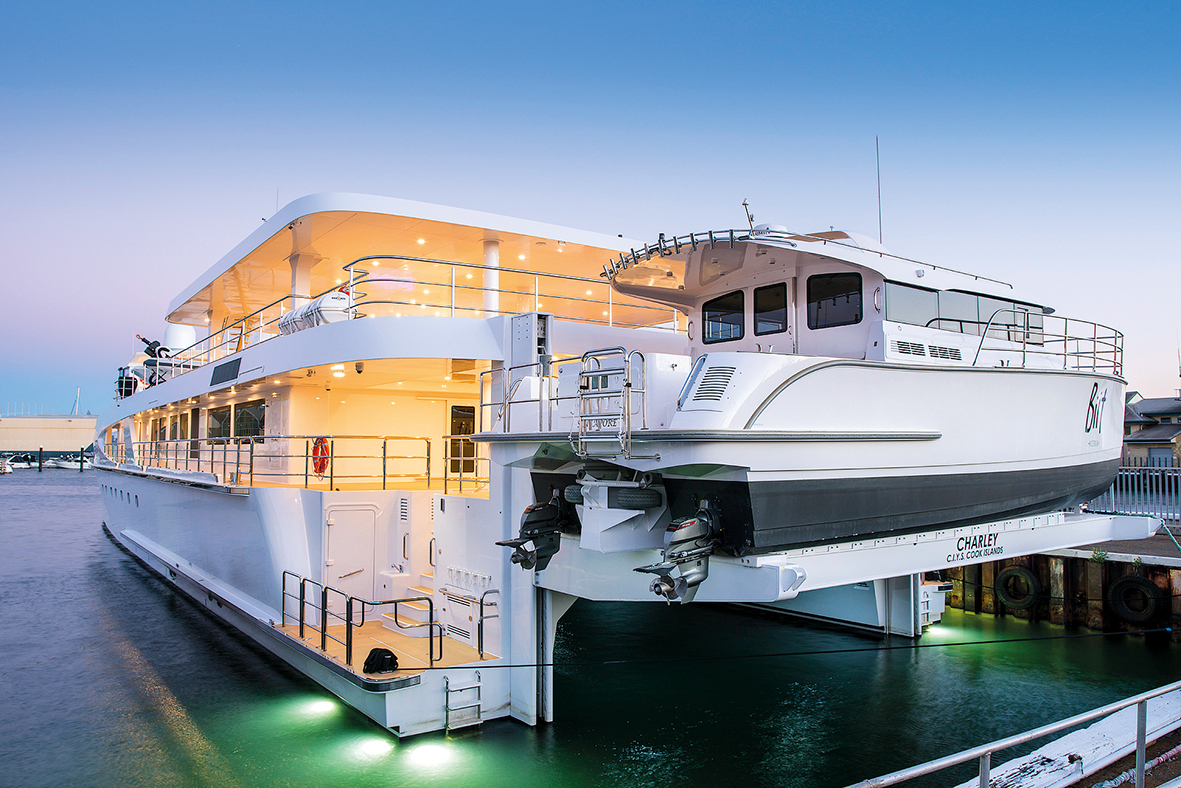 M/Y Charley 1 – 50-metre composite catamaran yacht support/adventure yacht, from Echo Yachts
M/Y Charley 1 – 50-metre composite catamaran yacht support/adventure yacht, from Echo Yachts
So why hasn’t this transformative shift gained more traction? Firstly, the vast majority of the ship-building industry in Europe is structured around traditional shipbuilding operations and tends to favour steel or composite construction for large monohulls. More to the point, designers, shipyard workers and infrastructure are tailored to accommodate narrow, long yachts.
Some shipbuilders have sheds with a beam of 14 metres, so they couldn’t build a large cat even if they wanted to. This trepidation extends to berthing spaces too, with the limited availability of space in prime marinas already a cause for concern for thinner monohulls, let alone bulkier multihulls with larger areas. This can be mitigated with side-to berthing options in challenging marinas.
Secondly, people tend to shy away from unfamiliar concepts. This is perceivably one of the core factors behind big cats not being built, with some shipbuilders not being as adventurous in building large multihulls as opposed to the tried and tested construction methods of monohulls that they are accustomed to.
“A lot of people have died on the rocks trying to be a superyacht builder,” says Smith. “You may well have an owner who is willing to embrace something new, but then you have an operational or project-management crew that doesn’t want to make a mistake. Everything hinges on the project going well, with little room for failure. We find the industry surprisingly risk-averse, and it is a big paradigm shift to go from a monohull to a cat.”
Choosing a catamaran for your support vessel is cost-effective, with the idea of designing two smaller vessels together becoming more common to reduce both the footprint and operational expenses.
From a naval architecture perspective, cats and trimarans present a greater challenge with regard to seakeeping where their ability is severely limited compared with the monohull when looking at wet-deck clearance and stability. If this is too low, then slamming will begin to occur, necessitating a change in course and speed. “There is no easy way out of this; it needs a wet-deck clearance that is aligned to the operating wave height and this will push up the vessel’s profile, which designers don’t like, and is at odds with a well-proportioned design in the context of a yacht profile,” says Roy.
“In this case, the use of semi-swath hulls and ride control systems could help. If you went to a full Small Water Plane Twin Hull (SWATH) solution, then your seakeeping is probably better than a monohull. However, these platforms are very niche and suited to very limited and specific operating envelopes. When you try and apply the ‘I want to wake up and go anywhere I like’ operating profile of a modern yacht, they are not suitable.”
Aesthetic preferences may play a role too, with some potential buyers preferring the traditional look of monohulls. “We have one client who, like many rep-resentatives of yachting’s current clientele, is quite involved in the process,” says Smith. “In this case, it’s a husband and wife. They love the idea of having two yachts, almost like a his-and-hers arrangement.
“He was very into our catamarans, which have that sort of Mercedes G-Wagon robustness, broad shoulders, you’d almost call it. That’s not what she was interested in when bringing her girlfriends out for a weekend in the Caribbean. It just didn’t have that iconic big white boat look she was into.”
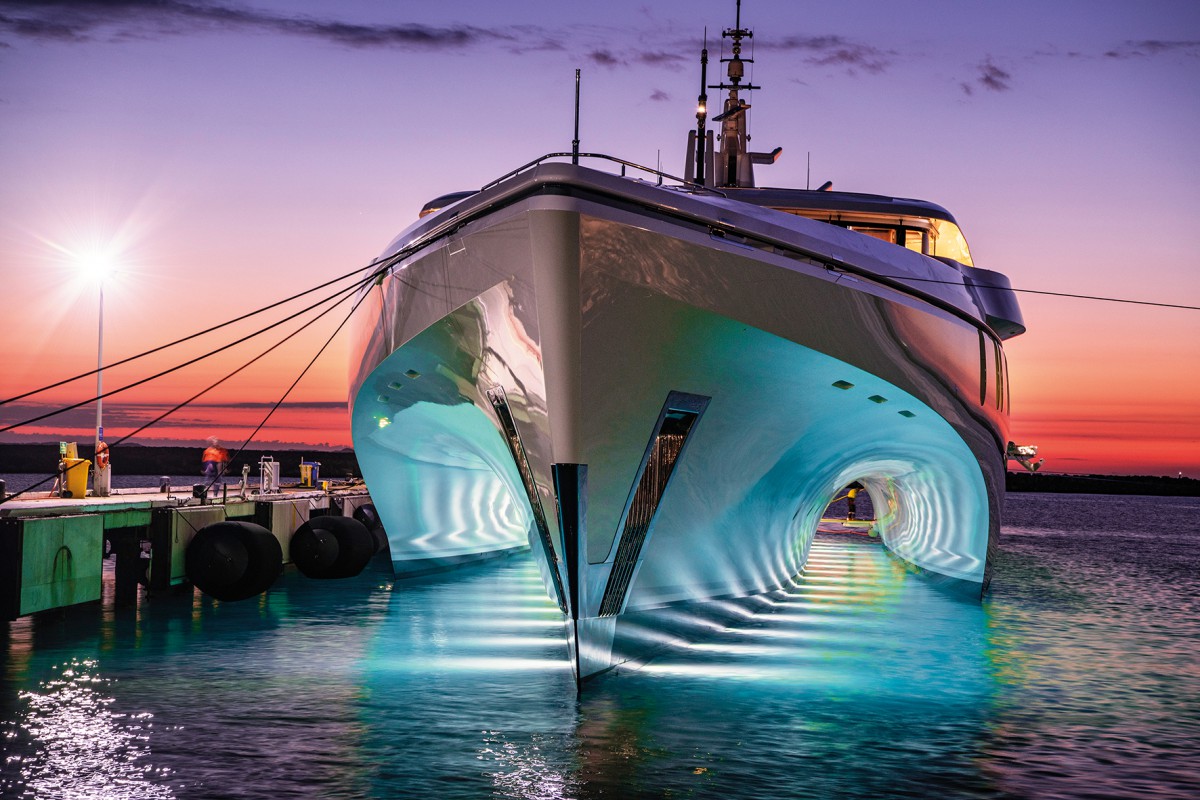 M/Y White Rabbit – 84-metre trimaran built in aluminium by Echo Yachts
M/Y White Rabbit – 84-metre trimaran built in aluminium by Echo Yachts
Disseminating the benefits of a big cat has also been challenging, and while catamarans have gained slightly more recognition, trimarans are still relatively newer in the market. One of the most impressive multihulls over the past two decades is the 64-metre trimaran White Rabbit. This vessel garnered so much admiration that the larger 84-metre trimaran of the same name, mentioned earlier, was subsequently commissioned by the owner and developed by Echo Yachts with numerous improvements.
The Perth-based boat builder completed this project towards the end of 2018 and had a brief opportunity in early 2019 to showcase it at the Singapore Yacht Show. During the event, notable shipbuilding figures from the Damen and Lürssen shipyards in attendance.
“They stepped aboard and were very complimentary about what they saw, particularly looking at the combination of usable space, comfort and quality of construction,” says Blackwell.
Despite the yacht going on to win numerous accolades and titles at award shows, Echo Yachts was hamstrung by the pandemic, with the lock-downs and the cancellation of events greatly impacting the shipyard’s promotional activities and overall exposure. With the vessel being harboured in Singapore, it isn’t as readily accessible as places such as Monaco or the US, where it could showcase what a large multihull superyacht has to offer to a broader audience.
However, in recent years, more owners, particularly younger ones, are beginning to recognise the benefits of multihulls as they step on board and experience them first-hand. Echo Yachts has showcased this again with its recent delivery of Charley 2, and also with its latest commission to build the world’s largest catamaran sailing superyacht, which will have an LOA of 57 metres upon completion.
As exposure continues to grow, so too will knowledge of the benefits of the big cats. “We have to get this exposure and understanding growing because the underlying reason for big cats not featuring on the market very often is that most captains and brokers around the world haven’t had the opportunity to step on board and experience them first hand,” adds Blackwell. “If they haven’t seen it, they tend to fear what they don’t know.”
The utilisation of space, greater stability and enhanced efficiency have become an increasingly attractive prospect for a variety of clients too, whether they are first-time buyers trying to find their sea legs or experienced owners looking to diversify their fleet and lower their operational costs.
If the typical monohull is a Ferrari, the larger multihulls are G-Wagons – a safari vessel built for traversing any terrain in all conditions, but with all the customisation, luxury and comfort options you get with an Italian sports car.
“I think there is a great coalescence between the faith of these new yacht owners and the faith of an active yacht owner and that product personality,” says Smith. “They are sporty, they are active, they want to adventure. They want to embrace these things. And they’re a little bolder when it comes to taking risks and doing different things. We have several prospective buyers looking to use our platform as their primary yacht now, and I think these are the reasons why we’ve got in development what we have.”
The aesthetics of the big cats may not be for everyone; they are broad, bulky and built for the open seas as much as they are able to cruise into shallow Caribbean coves. If the typical monohull is a Ferrari, the larger multihulls are G-Wagons – a safari vessel built for traversing any terrain in all conditions, but with all the customisation, luxury and comfort options you get with an Italian sports car.
And of course, there are also drawbacks in an operational sense, specifically when looking at their roles as superyachts. “We have done quite a few studies for clients analysing what is best. What we tend to find is you can make a quantified case for a multihull by analytical means based on efficiency. But when you look at the qualitative operational aspects of a multihull compared to a monohull, they do not suit yacht operation so well, taking balanced consideration across a wide range of operational factors. The monohull tends to dominate because it offers the best compromise of everything,” says Roy. “Having said that, it could just take one person to do a big multi-hull yacht really well to see others follow. All the technology is there and well-established.”
Whether or not multihulls will revolutionise the industry in the next decade is up for debate, but it’s certainly possible, especially when looking at their numerous advantages in efficiency, stability and versatility. And as more owners and builders become aware of their benefits, we may see a significant increase in their adoption in the coming years. Inescapably perhaps, there is always the perceived risk of doing something other than the normal monohull. In practice buyers want to be unique, but only up to a point.
The challenge lies in educating the industry about these innovations, and finding the balance between fuel efficiency, increased stability, greater usable space and not compromising what makes yachting enjoyable in the first place. It’s all a process of gradual education and acceptance within the new-build community and one that could lead to a different face of the industry in the years to come. Until then, the monohull remains king of the jungle … at least for now.
This article first appeared in The Superyacht Report – New Build focus. To gain access to The Superyacht Group’s full suite of content, publications, events and services, click here to join The Superyacht Group Community and become one of our members.
Profile links
NEW: Sign up for SuperyachtNewsweek!
Get the latest weekly news, in-depth reports, intelligence, and strategic insights, delivered directly from The Superyacht Group's editors and market analysts.
Stay at the forefront of the superyacht industry with SuperyachtNewsweek
Click here to become part of The Superyacht Group community, and join us in our mission to make this industry accessible to all, and prosperous for the long-term. We are offering access to the superyacht industry’s most comprehensive and longstanding archive of business-critical information, as well as a comprehensive, real-time superyacht fleet database, for just £10 per month, because we are One Industry with One Mission. Sign up here.
Related news
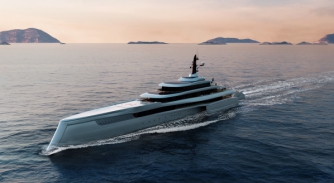
Lateral presents new 140-metre multihull project
The progressive naval architecture firm has introduced a new highly efficient and hydrodynamic 140m trimaran yacht concept with T. Fotiadis Design
Fleet
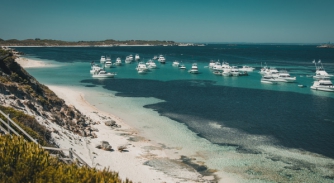
Echo Yachts to build world’s largest sailing catamaran
As the Western Australian industry continues to grow, the Perth-based shipbuilder will construct a fully custom 57-metre, twin-masted catamaran
Fleet
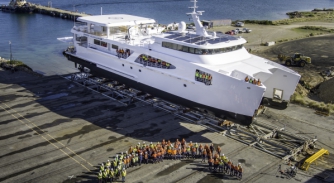
Echo Yachts launch 56m Charley 2
The aluminium catamaran adventure and support yacht is the largest catamaran motoryacht built in Australia
Fleet
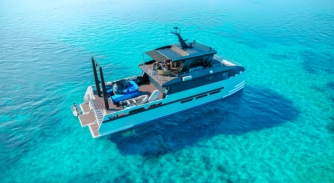
A new year is coming, what adventures will you take?
Amelia Smith from SHADOWCAT looks ahead to 2023
Fleet
Related news
Lateral presents new 140-metre multihull project
2 years ago
Echo Yachts launch 56m Charley 2
2 years ago
NEW: Sign up for
SuperyachtNewsweek!
Get the latest weekly news, in-depth reports, intelligence, and strategic insights, delivered directly from The Superyacht Group's editors and market analysts.
Stay at the forefront of the superyacht industry with SuperyachtNewsweek



